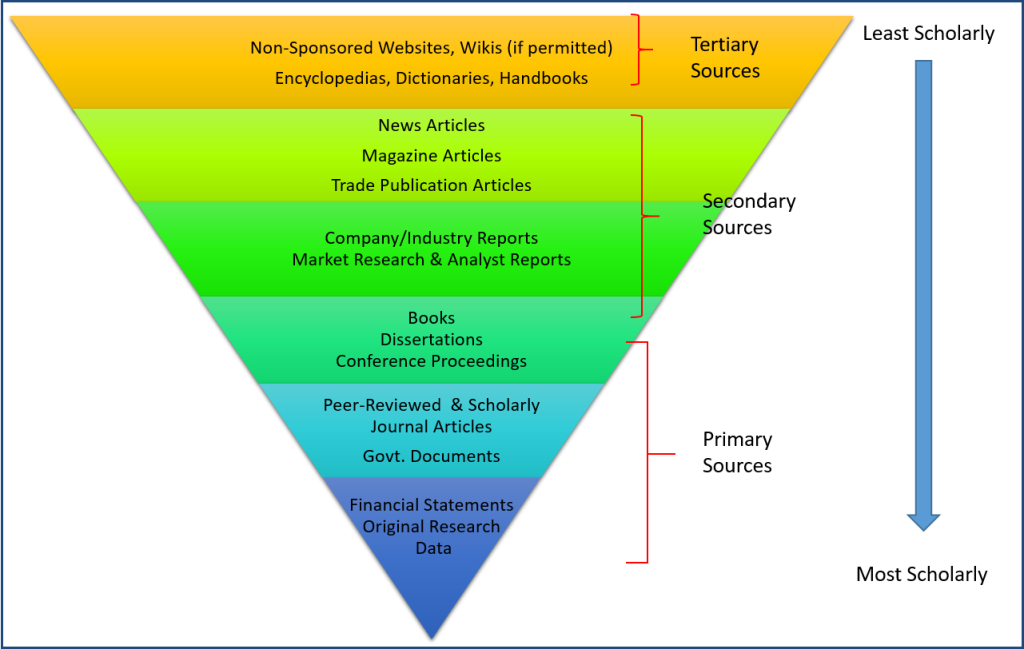Sources of Information at UNB Libraries
Leanne Wells
Introduction
Business information can come to us in many forms from virtually anywhere! The image below offers a small sample of the wide variety of sources available to you using UNB Libraries.
As you see, there are many different types of sources available to students. Each source has its place in helping to expand your understanding of a business topic. Not all sources of information are equal. Some assignments will require you to use different types of information sources.
When you’re in need of quality information for an assignment, UNB Libraries can help you to get started.

Visualizing Information Sources
The “Reverse Pyramid” of information sources shown below is designed to give business students an idea not only what the potential sources of business information look like but, more importantly, it attempts to place these sources in a hierarchy (in descending order) based on scholarly preference (from least scholarly to most scholarly).

What Is a Scholarly Source?
At the university level, scholarly sources are considered to be the product of original research which is then reviewed by other scholars before the results are published. Generally scholarly materials are written by scholars and researchers who are part of an academic community (e.g., professors, university researchers, PhD students, lecturers etc.)
Non-scholarly sources are written or produced for a more general audience outside of the academic community.


Primary Vs. Secondary Sources
The sources in the Reverse Pyramid can be further subdivided into primary sources and secondary sources of information. What constitutes a primary or secondary source? Defining primary and secondary sources can be a bit tricky as they can vary by discipline but there are a few general differences.
Primary Sources
A primary source is an original document/object that comes directly from the source during the time under study. Essentially, a primary source offers original thinking or data that has not been interpreted in any way.
In business, primary sources provide information about what a company (or person) says about itself. Examples include:
- annual reports, financial statements, press releases
- interviews, speeches, surveys
- eyewitness account of an event
- report of a new discovery
- peer-reviewed journal articles offering original research
- data resulting from original research
- diaries, letters, autobiographies
- tweets (e.g., tweets by celebrities, politicians, prominent business executives)
- original works such as novels, paintings, music
- patents
When university professors conduct scholarly research, they often consult primary sources.
Secondary Sources
Secondary sources, on the other hand, are documents that describe, analyze or interpret events that have already occurred. Secondary sources are removed from the time of the original event; as such, they interpret or give commentary about an original event or data.
In business, secondary sources provide information about what others think about a company, industry or person. Examples include:
- pre-packaged company, industry or market reports
- journal or magazine articles (that analyze or summarize the findings of others)
- newspaper articles (offering commentary or opinions)
- books (that interpret events, evaluate data, give a summary of a topic)
Learn more about primary vs. secondary sources by watching this short video courtesy of ResearchReady:
Libraries also purchase tertiary sources which list, summarize or repackage ideas/information from primary and secondary sources. A few examples of tertiary sources include:
- almanacs
- encyclopedias
- dictionaries
- handbooks
- textbooks can also be considered as tertiary sources.
QUICK TIP
Primary and secondary sources can vary by discipline, if you are required to consult primary sources for your assignment, please ask for clarification from your professor or your Teaching Assistant for the course.
What Sources Will My Professor Expect Me to Use?
University professors will often suggest the types of information sources that they expect students to read and use in their papers or assignments.
Try reading your course outline or your assignment handout for some pointers. Some professors may advise students that they should use only scholarly sources. Perhaps students might be asked to consult or include a primary source? If you’re not sure, ask your professor or your Teaching Assistant (TA) for clarification.
Whatever sources you use, your professor will expect you to acknowledge and cite the electronic and/or print sources you read and incorporate into your papers/assignments.
QUICK TIP
Professors expect students to include research from a few journals articles that come from “peer-reviewed” journals. These are sometimes referred to as “scholarly” or “academic” or “refereed” journals.
To discover more about scholarly journals and the peer-review process, move to the next chapters in this module.

